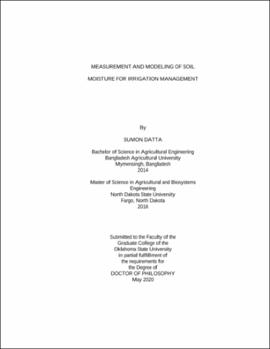| dc.contributor.advisor | Taghvaeian, Saleh | |
| dc.contributor.author | Datta, Sumon | |
| dc.date.accessioned | 2023-04-26T16:20:29Z | |
| dc.date.available | 2023-04-26T16:20:29Z | |
| dc.date.issued | 2020-05 | |
| dc.identifier.uri | https://hdl.handle.net/11244/337481 | |
| dc.description.abstract | Increasing strain on freshwater resources due to population growths, climate change, and excessive depletion of water resources necessitates research in maximizing beneficial water use in agriculture regions. Smart technologies have a vital role to play in achieving this goal. Soil moisture sensors (SMS) have been well-recognized as effective smart technologies due to their proven ability to deliver efficient and practical irrigation management. However, the adoption of SMS by agricultural producers has remained limited over the last 20 years. There is an urgent need to investigate the barriers behind the low adoption of SMS and conduct applied research projects to demonstrate the advantages of SMS utilization. The objectives of this study were to: (1) conduct a Strengths, Weaknesses, Opportunities, Threats (SWOT) analysis on published literature related to SMS applications in irrigation management to identify shortcomings and potentials; (2) assess the performance of commercially available soil moisture sensors in irrigated fields of Oklahoma; and, (3) investigate the performance of computer models in estimating soil moisture dynamics and quantifying irrigation fluxes under field conditions. The SWOT analysis revealed the lack of adequate local field studies in determining SMS accuracy, reliability, and affordability under variable soil and climatic conditions. The accuracy of five commercially available SMS was determined under variable soil texture and salinity in Oklahoma. The evaluation of moisture thresholds obtained from different methods showed the effects of threshold variability on practical irrigation management. Using a combination of measurement and modeling techniques, water fluxes in an agricultural watershed provided valuable information on actual irrigation practices employed by producers. This methodology can be applied to other irrigated areas to evaluate irrigation management strategies. | |
| dc.format | application/pdf | |
| dc.language | en_US | |
| dc.rights | Copyright is held by the author who has granted the Oklahoma State University Library the non-exclusive right to share this material in its institutional repository. Contact Digital Library Services at lib-dls@okstate.edu or 405-744-9161 for the permission policy on the use, reproduction or distribution of this material. | |
| dc.title | Measurement and modeling of soil moisture for irrigation management | |
| dc.contributor.committeeMember | Weckler, Paul | |
| dc.contributor.committeeMember | Gowda, Prasanna H. | |
| dc.contributor.committeeMember | Ochsner, Tyson E. | |
| osu.filename | Datta_okstate_0664D_16720.pdf | |
| osu.accesstype | Open Access | |
| dc.type.genre | Dissertation | |
| dc.type.material | Text | |
| dc.subject.keywords | irrigation | |
| dc.subject.keywords | irrigation management | |
| dc.subject.keywords | measurement | |
| dc.subject.keywords | sensors | |
| dc.subject.keywords | simulation | |
| dc.subject.keywords | soil moisture | |
| thesis.degree.discipline | Biosystems and Agricultural Engineering | |
| thesis.degree.grantor | Oklahoma State University | |
